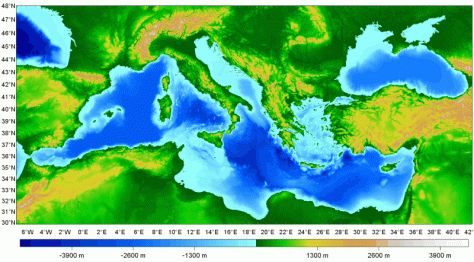The Mediterranean Sea is a “sea in the middle of the land” (Mare medi terraneum, in Latin). Do you know how many species live in this small sea? Do you know which is the average and maximum depth? These and more questions are answered in this post and are going to show you the magnificence of this sea.
HOW MANY SPECIES LIVE IN THE MEDITERRANEAN SEA?
Approximately 17,000 species have been reported to occur in the Mediterranean Sea. Did you think that they were more or less than 17,000? Of these, 26% are marine microbes (microorganisms), but it might be higher if we consider the very limited data available. If we just consider the animals, most of them are crustaceans (13.2%) and molluscs (12.4%), while vertebrates represent a small part (4.1%). Plants represent only a 5% of the amount of species. It’s important to highlight the presence of about 1,200 algae species, but authors have included them in the microbes and plants, despite they are not true plants.

These 17,000 species represent a 6.4% of the global species. Is this a lot or a little? If one considers that the Mediterranean Sea is only a 0.82% in surface area and 0.32% in volume as compared to the world oceans, draw conclusions yourself. It means that less than a 1% of the surface area of ocean have more than a 6% of the marine species!
The average of the total endemics is about 20%. It means that 20% of the species in the Mediterranean Sea can be found only in the Mediterranean. Some examples are the famous seagrass Posidonia oceanica, the emblematic Mediterranean monk seal (Monachus monachus), and the seaweed Rissoella verruculosa.

For all these reasons, the Mediterranean Sea is considered a hot spot of biodiversity, explained by paleogeographic and ecological reasons. From a paleogeographic point of view, its high species richness is due to both its long evolutionary history and the diversity pump from the Atlantic Ocean. In addition, from an ecological view, its species richness is due to the present-day variety of climatic and hydrologic situations, leading to the occurrence of temperate and subtropical species.
In this numbers, we have to add an additional 600 metazoan species. Who are they? The Mediterranean biodiversity is influenced by the introduction of 600 new species, which represent a 3.3% of the total estimates. In fact, this number is continuously increasing. Molluscs (33%), arthropods (18%) and chordates (17%) are the groups with more alien species. A well-known and toxic example is the blowfish.
IS THE MEDITERRANEAN SEA A DEEP SEA?
The Mediterranean sea is the deepest enclosed sea on Earth. It has an average depth of 1,460 m and a maximum of 5,267 m. The deepest part of the sea is placed on the Matapan trench, in Greece. We can compare the average and the maximum depth in other enclosed seas to give some evidence: Baltic Sea ( 55 and 421 m respectively), North Sea (94 and 660 m), Black Sea (1,240 and 2,245 m) and Red Sea (491 and 3,040 m).

What happens when we compare the Mediterranean Sea with the Earth’s oceans? In my opinion, the “sea between the land” don’t stay behind, but let’s see the numbers (average and maximum depth): Pacific Ocean (4,001 and 11,034 m), Atlantic Ocean (3,605 and 8,605 m), Indian Ocean (3,854 and 7,455 m), Southern Ocean (4,500 and 7,235 m) and Arctic Ocean (1,430 and 5,625 m).
DID YOU KNOW THAT THE MEDITERRANEAN SEA BECAME NEARLY DESICCATED?
About 6 million years ago, towards the end of the Miocene, the Mediterranean Sea was isolated from the rest of the world ocean. Because of the Mediterranean sea has a negative water balance, it is that evaporation is higher than the entrance of water, it become almost desiccated and, probably, was transformed into a series of large evaporitic lakes during the salinity crisis at the Messinian Stage.

Probably, the landscape during the salinity crisis should have looked like the nowadays Dead Sea. This salinity crisis should have driven deep water fauna to extinction, but some of the shallow-water biota may have survived.

OPEN OCEAN REPRESENTS 80% OF THE TOTAL MEDITERRANEAN WATERS
The continental shelves of the Mediterranean are narrow and crossed by submarine canyons, so open sea represents a large area. In fact, 80% of the total Mediterranean waters are open ocean and can be classified as deep sea. An unusual characteristic is the high homothermy from 300-500 m to the seafloor (there is an homogeneous temperature of 12.8 – 13.5ºC in the western Mediterranean and 13.5 – 15.5ºC in the eastern Mediterranean).
REFERENCES
- Ballesteros E & Llobet T (2015). Fauna i flora de la mar Mediterrània. Ed. Brau
- Bianchi CN & Morri C (2000). Marine Biodiversity of the Mediterranean Sea: Situation, Problems and Prospects for Future Research. Marine Pollution Bulletin. Vol. 40, No. 5, pp. 367-376
- Coll M, Piroddi C, Steenbeek J, Kaschner K, Ben Rais Lasram F, et al. (2010) The Biodiversity of the Mediterranean Sea: Estimates, Patterns, and Threats. PLoS ONE 5(8): e11842. doi:10.1371/journal.pone.0011842
- Hofrichter R (2004). El mar Mediterráneo. Fauna, Flora y Ecología: Guía sistemática y de identificación. Ed. Omega
- Hofrichter R (2004). El mar Mediterráneo. Fauna, Flora y Ecología: Parte general. Ed. Omega
- Hutchinson S & Hawkins LE (2005). Océanos. Biblioteca virtual. Scyla Editores
- Main picture: got from Pinake.


